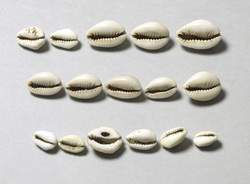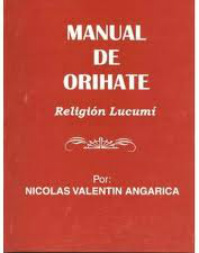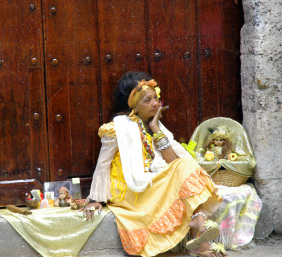What is Odu?

Cowrie shells reveal odu
Odu (odun) refers to one of the many letras (signs, patterns, letters) that fall when a Santero or Santera throws the dilogún (16 consecrated cowrie shells) when doing a consulta (reading). There are 16 basic patterns, known as the "parent" odu, but the first throw of the dilogún in a consulta is always a composite, made up of two parent odu. This opening pattern is called the entoyale, and it gives the diviner important information about the general themes that need to be addressed during the reading. Depending on how the shells fall, any of 256 possible composite patterns can turn up, and each one has its own specific characteristics that the diviner must be able to interpret. Santeros who want to be good diviners have to memorize as much information as they can about each odu. In Cuba, specific information about odu isn't traditionally shared with outsiders to the religion. It's considered sacred information, available only to initiated priests and priestesses, and it's carefully guarded by elders, who decide when and under what circumstances they want to share what they know with their godchildren. Learning the odu requires an enormous commitment of time and effort, and many Santeros aren't able to devote so much time to study. This explains why some Santeros don't do divination or offer consultas to clients. It's a highly specialized field and, to do it well, it requires years of practice.
Odu Convey Messages

A libreta
Nevertheless, almost everyone who practices Santería knows the names of the odu and some of the proverbs and patakís (sacred stories) attached to them. Patakís sometimes personify the odu and talk about their experiences when they were on earth. They're primordial beings, older than the Orichás, and they have a direct connection with Olofi (God) because they were among the first creations in the cosmos. At different points in time, they were sent to earth for some reason, where they interacted with the Orichás and human beings, and then they returned to heaven. Patakís explain the relationships between the odu and various Orichás, and help to explain why odu interact with humans in a particular manner. Academic folklorists say that Afro-Cuban odu are archetypes that reflect different human conditions. For practitioners of Santería, they're like divine messengers.
In traditional Regla de Ocha houses in Cuba, only the first 12 odu are read by Santeros/as. The remaining odu (13-14-15-16) are read by Babalawos. In other lineages, especially outside of Cuba, Santeros/as may read all 16 odu.
Each odu is represented by a number, which stands for the number of shells that fall face up on the mat. The basic odu patterns are:
(1) Okana
(2) Eyi Oko (Eyioso)
(3) Ogundá
(4) Iroso
(5) Oché
(6) Obara
(7) Odi
(8) Unle (Eyeunle)
(9) Osá
(10) Ofún (Ofún Mafun)
(11) Ojuani (Ojuani-Shober)
(12) Eyilá (Eyila Shebora)
(13) Metanla
(14) Merinla
(15) Marunla
(16) Meridilogún
Because so much of Santería's teaching have been transmitted via oral tradition, variations in spelling are fairly common when we find information in written form. Some libretas (notebooks) of old Cuban Santeros have been published and circulated in recent years, but most practioners agree you can't learn to read dilogún just by reading a book. Learning the odu requires years of training with an experienced elder.
In traditional Regla de Ocha houses in Cuba, only the first 12 odu are read by Santeros/as. The remaining odu (13-14-15-16) are read by Babalawos. In other lineages, especially outside of Cuba, Santeros/as may read all 16 odu.
Each odu is represented by a number, which stands for the number of shells that fall face up on the mat. The basic odu patterns are:
(1) Okana
(2) Eyi Oko (Eyioso)
(3) Ogundá
(4) Iroso
(5) Oché
(6) Obara
(7) Odi
(8) Unle (Eyeunle)
(9) Osá
(10) Ofún (Ofún Mafun)
(11) Ojuani (Ojuani-Shober)
(12) Eyilá (Eyila Shebora)
(13) Metanla
(14) Merinla
(15) Marunla
(16) Meridilogún
Because so much of Santería's teaching have been transmitted via oral tradition, variations in spelling are fairly common when we find information in written form. Some libretas (notebooks) of old Cuban Santeros have been published and circulated in recent years, but most practioners agree you can't learn to read dilogún just by reading a book. Learning the odu requires years of training with an experienced elder.
How do the odu guide us?

Always ask about the diviner's background.
The odu are divided into "major" and "minor" odu, which reflects the order in which they appeared on earth. The eldest odu is Unle, and the youngest is Oché. The hierarchy of the odu is important in consultas, because it tells the diviner how to interpret the information that falls on the mat.
Can anyone do divination with the dilogún? No, divination's a sacred ceremony and can only be practiced by initiated priests and priestess who've been properly trained.
Do some Santeros/as claim they're able to do readings when they actually can't? Absolutely. Some unscrupulous people pretend they're qualified when they aren't. To avoid fraud, you need to know who's giving you the reading, and what his or her qualifications are.
Can the odu relay information to us in other ways? Definitely. The proverbs associated with the odu are useful insights into human nature and can be applied as traditional folk wisdom to a wide variety of situations.
Can anyone do divination with the dilogún? No, divination's a sacred ceremony and can only be practiced by initiated priests and priestess who've been properly trained.
Do some Santeros/as claim they're able to do readings when they actually can't? Absolutely. Some unscrupulous people pretend they're qualified when they aren't. To avoid fraud, you need to know who's giving you the reading, and what his or her qualifications are.
Can the odu relay information to us in other ways? Definitely. The proverbs associated with the odu are useful insights into human nature and can be applied as traditional folk wisdom to a wide variety of situations.
